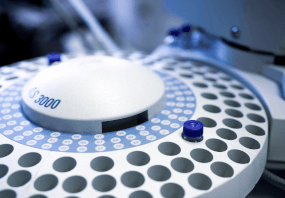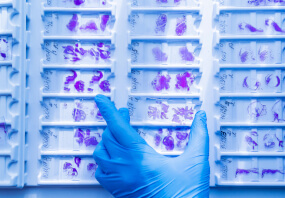General description
RE1-silencing transcription factor (UniProt: Q13127; also known as REST, Neural-restrictive silencer factor, X2 box repressor) is encoded by the REST (also known as NRSF, XBR) gene (Gene ID: 5978) in human. REST is a transcriptional repressor that acts by binding a DNA sequence element called the neuron-restrictive silencer element (NRSE). It is ubiquitously expressed, and higher expression is found in the tissues of the lymphocytic compartment, including spleen, thymus, peripheral blood lymphocytes, and ovary. It is also found in undifferentiated neuronal progenitor cells and is believed to acts as a master negative regular of neurogenesis. Expression of REST is reported to be cell cycle-dependent with reduced levels in the G2 phase. It is involved in maintaining the quiescent state of adult neural stem cells and prevents their premature differentiation into mature neurons. REST restricts the expression of neuronal genes by associating with two distinct corepressors, SIN3A and RCOR1, which in turn recruit histone deacetylase to the promoters of REST-regulated genes. REST also mediates repression by recruiting the BHC complex at RE1/NRSE sites, which acts by deacetylating and demethylating specific sites on histones and acting as a chromatin modifier. Mutations in REST gene can lead to Wilms tumors, a pediatric malignancy of the kidney that occurs due to uncontrolled multiplication of renal stem, stromal, and epithelial cells. (Ref.: Mahamdallie, SS., et al. (2015). Nat. Genet. 47(12); 1471-1474; Huang, Z., et al. (2011). Nat. Cell Biol. 13(2); 142-152).
Specificity
This Rabbit polyclonal antibody detects RE1-silencing transcription factor (REST). It targets an epitope within the C-terminal region.
Immunogen
GST-tagged recombinant fragment corresponding to 297 amino acids from the C-terminal region of human RE1-silencing transcription factor (REST).
Application
Anti-REST, Cat. No. 07-579, is a rabbit polyclonal antibody that detects REST and is tested for use in Western Blotting.
Research Category
Epigenetics & Nuclear Function
Research Sub Category
Transcription Factors
Updated information-Rest is glycosylated. From http://amsdottorato.cib.unibo.it/687/
From the summary:
"Finally, the glycosylation pattern of the REST protein was analysed, moving from the observation that the molecular weight calculated on REST sequence is about 116 kDa but using western blotting this transcription factor appears to have distinct apparent molecular weight (see Table 1.1): this difference could be explained by post-translational modifications of the proteins, like glycosylation. In fact recently, several studies underlined the importance of O-glycosylation in modulating transcriptional silencing, protein phosphorylation, protein degradation by proteasome and protein–protein interactions [Julenius et al., 2005; Zachara and Hart, 2006]. Deglycosilating analysis showed that REST protein in SH-SY5Y and HEK293 cells is Oglycosylated and not N-glycosylated. Moreover, using several combination of deglycosilating enzymes it is possible to hypothesize the presence of Gal-β(1-3)-GalNAc residues on the endogenous REST, while β(1-4)-linked galactose residues may be present on recombinant REST protein expressed in HEK293 cells. However, the O-glycosylation process produces an immense multiplicity of chemical structures and monosaccharides must be sequentially hydrolyzed by a series of exoglycosidase. Further experiments are needed to characterize all the post-translational modification of the transcription factor REST." In particular the authors show that REST migrates at 200kd in SH-SY5Y cells.
Quality
Evaluated by Western Blotting in HEK293 cell lysate.Western Blotting Analysis: A 1:1,000 dilution of this antibody detected REST in HEK293 cell lysate.
Target description
~160 kDa observed; 121.87 kDa calculated. Uncharacterized bands may be observed in some lysate(s).
Physical form
Format: Purified
Protein A purified
Purified rabbit polyclonal antibody in buffer containing 0.014 M phosphate buffer, pH 7.6, 0.175 M NaCl with 0.07% sodium azide with 30% glycerol.
Storage and Stability
Store at -10°C to -25°C. Handling Recommendations: Upon receipt and prior to removing the cap, centrifuge the vial and gently mix the solution. Aliquot into microcentrifuge tubes and store at -20°C. Avoid repeated freeze/thaw cycles, which may damage IgG and affect product performance.
Analysis Note
Control
Positive Antigen Control: Catalog #12-309, Hela cell nuclear extract. Add an equal volume of Laemmli reducing sample buffer to 10 μL of extract and boil for 5 minutes to reduce the preparation. Load 20 μg of reduced extract per lane for minigels.
Other Notes
Concentration: Please refer to the Certificate of Analysis for the lot-specific concentration.
Legal Information
UPSTATE is a registered trademark of Merck KGaA, Darmstadt, Germany
Disclaimer
Unless otherwise stated in our catalog or other company documentation accompanying the product(s), our products are intended for research use only and are not to be used for any other purpose, which includes but is not limited to, unauthorized commercial uses, in vitro diagnostic uses, ex vivo or in vivo therapeutic uses or any type of consumption or application to humans or animals.
Shipping Information:
Dry Ice Surcharge & Ice Pack Shipments: $40
More Information: https://cenmed.com/shipping-returns
- UPC:
- 51181607
- Condition:
- New
- Availability:
- 3-5 Days
- Weight:
- 1.00 Ounces
- HazmatClass:
- No
- MPN:
- 07-579
- Temperature Control Device:
- Yes












